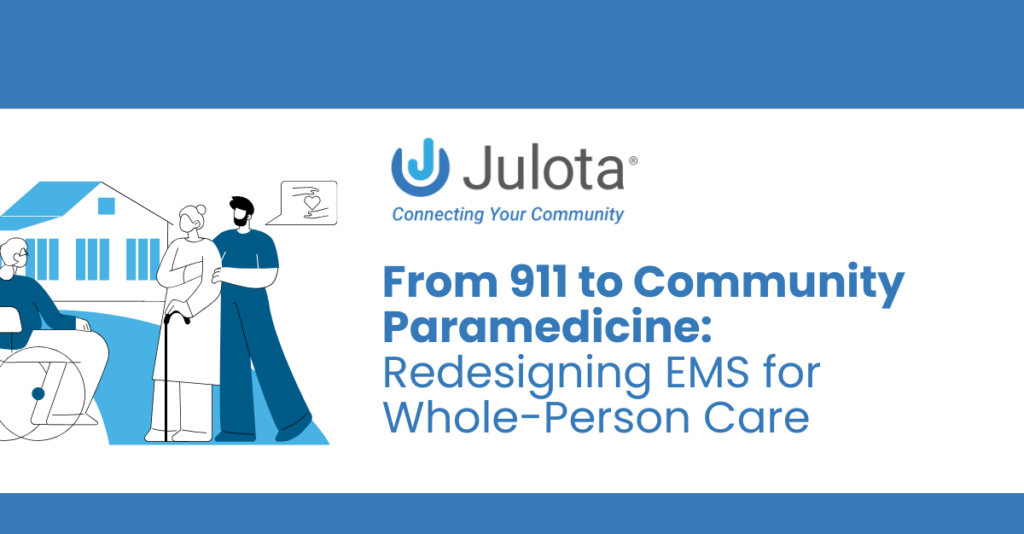In the past, ambulances would respond to a 911 call, snag the patient, and rush to the hospital. If the patient were lucky, they’d receive fundamental emergency care. Thankfully, over the years, EMS has increasingly shifted toward holistic, whole-person care. In this article, we’ll explore the process of evolving EMS into community paramedicine.
Community paramedicine provides patients who have called 911 with an alternative option after receiving emergency care. Many times, those who call 911 need more than just a moment of care; they require a program that can follow up and ensure follow-through. Community paramedicine can specifically help those 911 callers who are super-utilizers, working through uncontrolled chronic diseases, and dealing with mental health struggles.

Evolving EMS into Community Paramedicine and Beyond
EMS is fascinating. This applies to the work they do every day, as well as the profession’s potential for growth and continued impact on the field of medicine and the lives of people. Below, we’re going to talk about some of the ways EMS is evolving to provide whole-person care (rather than just treating a single illness at a single time).
Here is how EMS is working toward whole-person care:
- Building Community Paramedicine Teams to look at the long-term problems
- Community Paramedicine: Take Time with Patients when possible
- Community Paramedicine is reducing super utilizers
- Helping combat negative social determinants of health
- Telemedicine and MIH-CP are a good partnership
- Community Paramedicine Changes 911 Calls from Single Events to Trending Data
The goal is not to make every EMS system look the same. That would be counterintuitive. Rather, the goal is to see more EMS agencies innovating in their communities, finding ways to overcome the obstacles they face and to improve for themselves and the people they serve.
Community Paramedicine is Always Looking at the Long-Term
As we mentioned, EMS initially operated as a load-and-go system, where individuals with medical emergencies were quickly transported to the ER. The idea was simple: get people to the hospital as fast as possible.
However, things changed. More and more people began using 911 as a general help line, rather than just an emergency number. As the people using EMS have changed, so has the EMS system.
Now, EMS services are looking at the long-term. Rather than just focusing on how they will respond to emergencies today, they are looking at their population with a holistic, wide-angle lens. And they’re asking questions such as, ‘ Where is the community going in terms of health? ‘ Do we expect to see a rise in the number of people with chronic diseases?
What kind of health infrastructure is available? Those communities that have a small town supporting them may be seeing fewer and fewer physicians in the area, or they may see their hospital close up shop completely.
EMS has now realized that they don’t live in a bubble. While some areas have been resistant to change, others have recognized that they need to address both short-term and long-term issues if they are to remain effective in managing patients and retaining a strong and vibrant workforce.
Community Paramedicine: Take Time with Patients When Possible
Part of that long-term mindset involves many EMS systems establishing community paramedic teams. The idea behind these teams is that Mobile Integrated Healthcare (MIH) teams can dedicate more time to understanding some of the more complex cases in a given area.
When someone falls and breaks their arm, you might think it’s a simple matter of picking them up, placing a splint, and driving them to the hospital. In some cases, it is as simple as that. However, when the patient has fallen ten times in the last month and they’ve broken both hands (with a fractured hip just around the corner), suddenly the complexity of the situation becomes apparent.
In many systems, the 911 EMS crews can flag patients as potentially good candidates for follow-up with the community paramedicine team. This provides paramedics and EMTs with a valuable resource for assisting their patients. Not only does this tangibly help people, but it can also boost morale within EMS, as it reduces the number of providers who feel helpless when they encounter a challenging case.
EMS is Working with Community Paramedicine to Reduce Super-Utilizers
If you hang around any fire department or EMS service long enough, you’ll inevitably hear about the people that the paramedics run on constantly. These individuals are often referred to as “frequent flyers” or “super-utilizers.” The numbers can vary depending on the area, but there is usually a specific threshold that someone must meet (e.g., the number of 911 calls in a year) to be classified as a super utilizer.
In some areas, someone who calls 911 twice a month might be classified as a super utilizer. Other areas may not even blink an eye at that; they are more worried about people who call twice a week — or every day!
While some people may call 911 more frequently than others, it reaches a point where regular calls to the same person become a problem for everyone. First and foremost, it’s a problem for the person making the call because if they have to dial 911 twice a week, something isn’t right in their life.
Second, it’s not good for the EMS agency. Not only does it begin to sap the personnel of the field providers, but it can also become quite costly. Super-utilizers often utilize a significant amount of EMS resources but generate very little revenue.
Third, the hospital is impacted because many super-utilizers want to go to the ER. This presents a problem for emergency rooms that are understaffed and already overwhelmed with people having legitimate life-threatening health crises.
And last, the community is hurt. There are many sad stories about ambulances not being available for someone having a real emergency because they were tied up with a non-emergency situation involving a super-utilizer or someone else who is misusing the 911 system.
EMS Combating Negative Social Determinants of Health
Social determinants of health refer to the factors that can predispose a person to a greater risk of a specific injury or illness. For example, someone who works in a dirty air environment may be more likely to have lung problems.
Similarly, someone who lives in a high-crime area may be at greater risk of trauma and have less access to quality medical care. EMS works to combat negative social determinants of health and bring some level of equity and access for people in high-risk areas.
For example, for those living in underserved rural areas, EMS may develop programs to deliver the medical care that is lacking. This could include neonatal care for newborns or maternal care for mothers preparing to have a baby.
Using tools like telemedicine and field-capable diagnostics, community paramedics and EMTs can help these individuals overcome the inherent disadvantages of their living environment or the circumstances into which they were born.
Telemedicine and EMS are a Good Partnership
Another way that EMS is evolving is with tools like telemedicine. Telemedicine has been around for some time, but it continues to gain popularity. These days, many EMS services have not yet integrated telemedicine into their day-to-day practice; however, others have recognized the benefits that telemedicine can bring.
Telemedicine in EMS allows paramedics and EMTs to contact medical control and get highly accurate and specific feedback in the field. It also allows physicians to get more hands-on (virtually) with critical trauma patients.
For example, take someone who has experienced abdominal trauma. The paramedic can use telemedicine to provide the ER physician with a live feed of the field ultrasound, which in turn will allow the provider to get an early idea of the patient’s condition. This leads to better triage and transport decisions for the patient, as well as an improved relationship between the hospital and the ambulance service.
Too often, confusion arises with just a phone call. In many cases, the physicians are forced to just take the provider’s word for something. While this works fine when there is a system of trust between EMS and ER, it can be an issue for busy systems where the physician may not be familiar with the EMS crew.
In these cases, if the physician is not comfortable with a particular aspect, they are unlikely to allow EMS to perform an advanced procedure or make an aggressive clinical decision. The result is that patients receive less than optimal care, simply because communication is poor between the doctor and the paramedic. Telemedicine helps fix this problem.
Conclusion: Evolving EMS into Community Paramedicine Changes 911 Calls from Single Events to Trending Data
EMS looks very different from what it was thirty years ago, and it will continue to change. EMS teams are developing comprehensive care systems by implementing community paramedic programs, exploring the needs of super-utilizers, and utilizing modern tools such as video calls for telemedicine.
But nothing can be improved if it isn’t being safely tracked, and you can’t track many different things without the right platform to do so. If you’re serious about evolving your EMS program into community paramedicine and building a service that is ready to meet the demands of the modern age, consider using Julota’s software tools.
Julota is a safe platform designed to help EMS systems track long-term patient data and easily share that data with community partners. Contact Julota now for a hassle-free demonstration.
